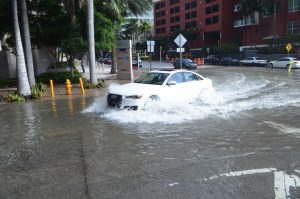
This blog was written by Kelsey Grentzer, former Florida Communications Coordinator at the Southern Alliance for Clean Energy.
The rate of sea level rise has been accelerating in recent decades, and a recent study by First Street Foundation shows that homes in the southeastern U.S. are already losing value as a result.
According to the National Oceanic and Atmospheric Administration (NOAA), scientists are “very confident” that we will see a global average sea level rise between eight inches and 6.6 feet by the end of the century. Unfortunately for coastal residents, rising sea levels mean more frequent tidal flooding and greater hurricane storm surge.
Miami Beach and other coastal cities are already seeing frequent flooding. NOAA recently examined 98 U.S. coastal locations and found that more than 25 percent of them tied or broke their records for high tide flood days in 2017. “Breaking of annual flood records is to be expected next year and for decades to come as sea levels rise,” according to the NOAA’s National Climate Report.
Wondering how your home will fare? A new tool is now available to see how sea level rise and the resulting increases in tidal flooding and hurricane storm surge are expected to affect your property value. Using data from First Street Foundation’s recent study, the interactive FloodiQ website allows you to search by address or city and see both expected flooding and property value loss for your area.
The website currently includes data for Florida, Georgia, South Carolina, North Carolina and Virginia, and FloodiQ plans to add data from the remaining at-risk U.S. coastal regions.
According to FloodiQ, impacted properties in Miami, Florida, have already lost more than $125 million in real-estate market value since 2005, and without action, they will continue to lose more than $143 million between now and 2033. Properties in Tampa, Florida — another vulnerable area when it comes to the effects of sea level rise — have lost more than $76 million since 2005 and are projected to lose another $87 million by 2033 if we do not act now.
The FloodiQ images below show potential storm surge flooding in Florida’s Tampa Bay and Miami areas during a Category 5 hurricane, with purple indicating three or more feet of flooding. The projections do not include additional flooding that could result from rain.


How will your home be affected by sea level rise in the coming years? See for yourself on FloodiQ’s interactive website.: FloodiQ.com
To learn more about what you can do to help mitigate sea level rise, read our other blog post, Four Ways Your Actions Can Help Combat Sea Level Rise.